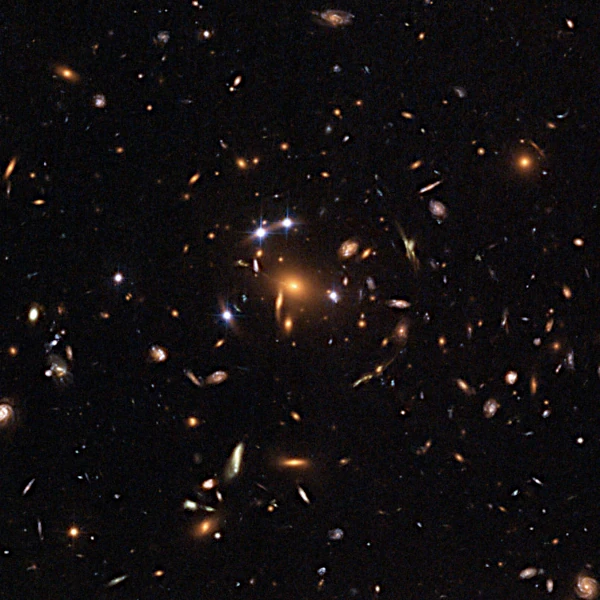
According to Einstein's general relativity, mass deforms the geometry of spacetime. Light, which follows the curvature of this spacetime, is thus deflected when it passes near a massive object, such as a galaxy or a cluster of galaxies. This phenomenon is called a gravitational lens.
Gravitational lenses act as natural telescopes, amplifying the light from very distant galaxies and revealing details that would otherwise be inaccessible. Thanks to this effect, astronomers can observe the Universe as it was a few hundred million years after the Big Bang, and thus study the formation of the first galaxies and stars.
Beyond their amplifying power, gravitational lenses are powerful tracers of dark matter. By analyzing the distortion of background galaxy images, researchers can map the mass distribution in galaxy clusters, including the invisible component. This technique, called weak gravitational lensing, allows probing the large-scale structure of the Universe and testing models of cosmic formation.
Strong gravitational lenses, on the other hand, produce multiple images of the same distant object, such as a quasar. By measuring the time delays between these images—due to differences in path and gravitational potential—scientists can constrain fundamental cosmological parameters, including the Hubble constant \(H_0\), which describes the expansion rate of the Universe. These independent measurements are valuable for resolving current tensions between different methods of estimating \(H_0\).
Finally, gravitational lenses play a key role in detecting compact objects such as black holes or exoplanets through microlensing events. They thus open a window onto a variety of astrophysical phenomena, while remaining a central tool for exploring the fundamental laws that govern the cosmos.
This table presents a selection of famous gravitational lenses, illustrating the diversity of observed phenomena: strong lenses producing multiple images or Einstein rings, microlenses revealing compact objects, and weak lenses allowing the mapping of dark matter. Each contributes in its own way to our understanding of the Universe.
| Name / Designation | Type | Discovery | Particularity |
|---|---|---|---|
| QSO 0957+561 | Strong lensing | 1979 | First quasar with multiple observed images |
| Einstein Ring of ER 0047-2808 | Strong lensing | 1998 | Near-perfect ring produced by an elliptical galaxy |
| OGLE Program | Microlensing | 1992– | Detection of exoplanets through gravitational amplification |
| Hubble Frontier Fields | Weak and strong lensing | 2014 | Observation of the most distant galaxies thanks to massive clusters |
| SDSS J1004+4112 | Strong lensing | 2003 | First case of a lens produced by a galaxy cluster, with five images of a quasar |
| MACS J1149+2223 | Strong lensing | 2014 | Allows observation of the Refsdal supernova through multiple time-delayed images |
| Cosmic Horseshoe | Strong lensing | 2007 | Horseshoe-shaped structure caused by a massive galaxy |
| Bullet Cluster (1E 0657-56) | Weak lensing | 2006 | Indirect evidence of dark matter via the separation between visible mass and gravitational mass |